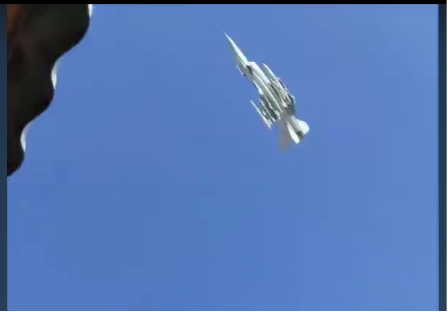In a historic first for NATO air operations and a probable air challenge to the Kremlin, a pair of US Air Force B-52 heavy bombers landed on Sunday at the Mihail Kogălniceanu Air Base in eastern Romania.
The route of flight taken by the American long-range strike aircraft paralleled almost the entire eastern frontier of NATO territory, from the Barents Sea north of Finland to the Black Sea.
JOIN US ON TELEGRAM
Follow our coverage of the war on the @Kyivpost_official.
Although remaining in international airspace, the US heavies made a provocative close pass of the Kola Peninsula and a giant air base used by Russia for bomber strikes against Ukraine.
It was the first time B-52H heavy bombers had ever landed in Romania, a US Air Force statement said. The last time the Stratofortress bombers had been present in airspace proximate to the Black Sea was in August 2023, a Kyiv Post review of open-source flight tracking records showed.


Chechens Remember, Chechens Resist, Chechens Will Be Free
On Sunday, Russia’s Defense Ministry said it launched MiG-29 and MiG-31 fighters to intercept the US bombers in international airspace over the Barents Sea. The American bombers turned away from Russian airspace “making a U-turn away from the ‘Russian’ state border” and the Russian interceptors landed without incident, the Kremlin statement said.
According to Ukrainian military information platforms, the US bombers once arriving near Finland flew towards Russia’s northern Kola Peninsula, a territory containing critical Kremlin strategic air warfare installations, radars, and military airfields.
The American B-52s flew a circular orbit off-shore from Russia’s main strategic hub in the region, the city of Murmansk, before proceeding south, those reports said.
The eight-engine US bombers were escorted by at least two Finnish Air Force F-18 fighters during part of a 3,000-plus kilometer journey along NATO’s eastern frontier. US official statements said all aircraft proceeded on planned flight paths without incidents.
A Finnish Air Force statement said a flight of F-18 fighters will for the first time participate in air policing operations over Romania and the Black Sea, after deploying to Mihail Kogălniceanu Air Base. The pilots and ground crew who deployed to Romania were from the Finnish Air Force’s Karelia Air Wing, the statement said.
Two Romanian F-16 fighters joined the American and Finnish planes during the second half of the flight.
US Air Force official images showed the American bombers refueling after an airborne rendezvous with an American KC-135 tanker aircraft flying out of Mildenhall AB, UK. Two other tanker aircraft also supported the operation, the UNIAN news agency reported.
A US Navy Poseidon maritime surveillance aircraft appeared in airspace over eastern Romania at about 11:00 a.m. and flew a standard patrol pattern for the rest of the day, open-source flight tracking data showed.
A US Air Force statement said the B-52s and their crews are assigned to the 2nd Bomb Wing, Barksdale Air Force Base, Louisiana, and will fly out of Mihail Kogălniceanu Airbase for a training exercise called Bomber Task Force 24-4.
“[I]t is vital that we are postured to deliver a range of sustainable capability from great distances,” said Gen. James Hecker, USAFE-AFAFRICA commander. “Through collaborative efforts with our Allies, the US enables our forces to combat current and future threats.”

The B-52H is a Cold War-era aircraft originally designed to drop bombs on strategic targets. The Pentagon has continually upgraded the aircraft, which its pilots commonly call the “BUFF” (an acronym sometimes meaning Big, Ugly, Flying Fellow – or F****r) with modern weaponry and avionics.
Russian Tu-95 “Bear” bombers based at Oleniya base, a shoreside naval and air force facility 25 kilometers north of Murmansk, have hit Ukrainian homes and businesses with hundreds of air-launched, long-range cruise missiles since Russia’s February 2022 invasion of Ukraine. On Saturday, during an interview aired by BBC, Ukrainian President Volodymyr Zelensky appealed to Ukraine’s allies for some means to attack the Russian bombers and bomber bases.
In a conflict against a near-peer opponent like Russia, US Air Force planners would probably use B-52s as a mobile platform to launch precision-guided cruise missiles from outside the range of shore-based air defenses.
Once an infrequently used military airfield in a remote region of NATO, Romania’s Mihail Kogălniceanu in past months has been heavily upgraded to increase capacity to handle intense air operations in the Black Sea region According to news reports, the site will eventually become NATO’s single largest air base.
Sunday’s arrival of B-52 bombers, an aircraft requiring exceptionally long runways and extensive ground support facilities, at Mihail Kogălniceanu was the first proof-positive demonstration that the base in south-east Romania could handle practically any plane fielded by NATO air forces.
The base has seen repeated deployments by lighter military fighters and logistics aircraft from multiple NATO national air forces to beef up air defenses, reconnaissance operations, and strike capability in the region. Among other formations, a two-ship element of British Royal Air Force Typhoon fighters operates from the base.
You can also highlight the text and press Ctrl + Enter











